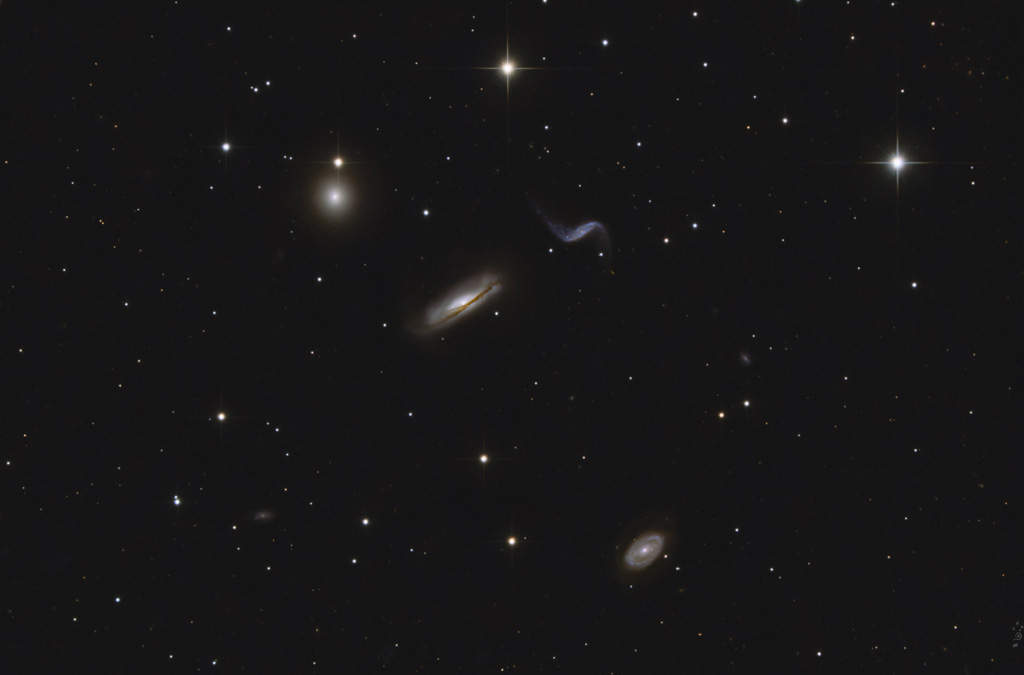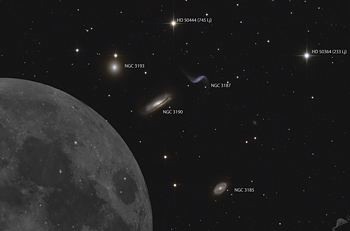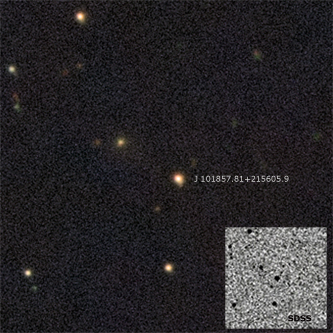 |
CHAMÄLEON + ONJALA OBSERVATORY DeepSky | SITEMAP HOME CHAMÄLEON |
|
 |
|||
| « zurück zur Startseite
Galaxien « back to home galaxies |
Großes Bild laden - load large image 2048 x 1400 Pixel Aufnahmedaten Image data |
Hickson 44 - NGC 3190, NGC 3187, NGC 3192 and NGC 3185 + SDSS - J 101833.32+215138.2 und SDSS - J 101857.81+215605.9

Hickson 44 - Diese kleine, aber sehr schöne Galaxiengruppe, liegt m Sternbild Löwe. NGC 3190 ist das Zentrum dieser Gruppe, die auch unter den Namen Hickson 44 oder Arp 316 katalogisiert sind. Sie enthält 3 Spiralgalaxien und eine elliptische Galaxie. Die beiden zentralen Spiralgalaxien - NGC 3190 und NGC 3187 - zeigen mit ihren verformten Spiralarmen deutlich die gravitativen Wechselwirkung der Galaxien untereinander. Bei NGC 3187 sind die Spiralarme wie bei einem Rasensprenger verbogen und ihre blaue Farbe deutet auf eine heftige Sternentstehungsrate hin. Die beiden anderen größeren Galaxien in unserem Bild gehören zu der Gruppe, wechselwirken aber offenbar nicht mit NGC 3187 und NGC 3190.
Die Entfernung von NGC 3190 zum Sonnensystem beträgt ca. 53 Millionen Lichtjahren, hat einen wahren Durchmesser von etwa 75.000 Lichtjahren und wurde am 12. März 1784 von Friedrich Wilhelm Herschel entdeckt. Den kompletten Katalog von wechselwirkenden Galaxiengruppen von Halton Arp finden Sie online hier, den der Hickson Compact Group (HCG) hier.
Object description
Hickson 44 - This small but very beautiful group of galaxies lies in the constellation Leo. NGC 3190 is the center of this group, which is also cataloged under the names Hickson 44 or Arp 316. It contains 3 spiral galaxies and one elliptical galaxy. The two central spiral galaxies - NGC 3190 and NGC 3187 - with their deformed spiral arms clearly show the gravitational interaction between the galaxies. In NGC 3187, the spiral arms are bent like a lawn sprinkler and their blue color indicates a strong star formation rate.
 |
The two other larger galaxies in our image belong to the group,
but apparently do not interact with NGC 3187 and NGC 3190. The distance of NGC 3190 to the solar system is about 53 million light years, has a true diameter of about 75,000 light years and was discovered by Friedrich Wilhelm Herschel on March 12, 1784. The complete catalog of interacting galaxy groups by Halton Arp can be found online here, that of the Hickson Compact Group (HCG) here. « Klicken Sie hier oder auf das Vorschaubild zum Laden eines großen Bildes mit Objektbezeichnungen. « « Click here or on the thumbnail to load a large image with object annotations. |
SDSS - J 101833.32+215138.2 bei den Koordinaten 10h 18m 32.7s und +21 51 36.4 ist eine kleine kompakte Galaxiengruppe der visuellen Helligkeit von 17m8 mit einer Rotverschiebung von z = 0.48 was einer Entfernung von etwa 5 Milliarden Lichtjahren entspricht.
SDSS - J 101857.81+215605.9 bei den Koordinaten 10h 18m 57.81 und +21 56 06.0 ist noch wesentlich weiter entfernt. Es ist vermutlich ein Quasar (der aktive Kern einer Galaxie, der im sichtbaren Bereich des Lichts nahezu punktförmig erscheint) mit der visuellen Helligkeit 18m0 mit einer Rotverschiebung von z = 4.7. Das entspricht grob einer Entfernung von knapp 13 Milliarden Lichtjahren.
Die recherchierten Daten dazu stammen aus der Datenbank des NASA/IPAC Extragalactic Database.
 |
 |
 |
|
J 101833.32+215138.2 + J 101857.81+215605.9 Übersicht - 100 % |
Galaxien - J 101833.32+215138.2 Detail - 300 % |
Quasar - J 101857.81+215605.9 Detail - 300 % |
SDSS - J 101833.32+215138.2 at coordinates 10h 18m 32.7s and +21 51 36.4 is a small compact galaxy group of visual magnitude 17m8 with a redshift of z = 0.48 which corresponds to a distance of about 5 billion light years.
SDSS - J 101833.32+215138.2SDSS - J 101857.81+215605.9 at coordinates 10h 18m 57.81 and +21 56 06.0 is much further away. It is probably a quasar (the active nucleus of a galaxy that appears almost point-like in the visible range of light) with a visual magnitude of 18m0 and a redshift of z = 4.7. This roughly corresponds to a distance of almost 13 billion light years.
The researched data comes from the NASA/IPAC Extragalactic Database
Hickson 44 - NGC 3190, NGC 3187, NGC 3192 and NGC 3185
Image data
Date: 10.-22.05.2023 - 32 x 600 s s, QHY ALccd 12 (cooled)
Telescope: CDK 12.5" PlaneWave Astrograph + 0.8x Reducer at f = 2030 mmm
Location: Chamäleon Observatory, Onjala Lodge, Namibia
Image acquisition and processing: DeepSkyStacker, PixInsight + Photoshop
 |
 |
 |
 |
 |
 |
 |
| Sonne | Mond | Sonnensystem | DeepSky | Weitwinkel | Verschiedenes | Spez. Projekte |